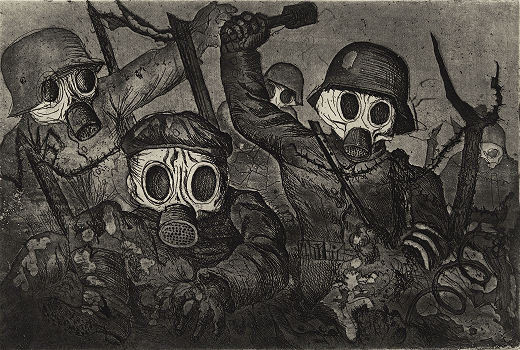Otto Dix
08 Mar - 27 Apr 2014

Otto Dix (1891–1969)
Sturmtruppe geht unter Gas vor, 1924, (aus der Folge: „Der Krieg", Radierwerk VI, Blatt 12, Mappe 2.II), Radierung, Aquatinta und Kaltnadel, Hamburger Kunsthalle / bpk, VG Bild-Kunst, Bonn 2014, Photo: Christoph Irrgang
Sturmtruppe geht unter Gas vor, 1924, (aus der Folge: „Der Krieg", Radierwerk VI, Blatt 12, Mappe 2.II), Radierung, Aquatinta und Kaltnadel, Hamburger Kunsthalle / bpk, VG Bild-Kunst, Bonn 2014, Photo: Christoph Irrgang
OTTO DIX
Der Krieg
8 March - 27 April 2014
Curators: Dr. Andreas Stolzenburg und Dr. David Klemm
The First World War has been described as "the great seminal catastrophe" of the twentieth century. The German artist Otto Dix (1891–1969) served as a soldier on both the Eastern and Western fronts, and documented his experiences in shockingly realistic images. Characterised by their ruthless portrayal of the brutality of war, Dix's works are among the most powerful indictments of war ever conceived, along with those of Callot, Goya and Picasso.
In 1923/24 Otto Dix produced a cycle of 50 etchings entitled "Der Krieg" (The War). He was encouraged to produce this portfolio by the Berlin art dealer Karl Nierendorf, who published it in an edition of 70 in the "Anti-War Year" of 1924. Around 1930, using the painting techniques of the Old Masters, Dix created "Der Krieg", a triptych that is regarded as one of his major works (Dresden, Galerie Neue Meister of the Staatliche Kunstsammlungen).
To mark the centenary of the outbreak of the First World War, the Hamburger Kunsthalle's Kupferstichkabinett is showing works by Otto Dix from its own holdings. The display features selected etchings from the cycle "Der Krieg" as well as rarely shown cartoons (full-size preliminary drawings) for the painting "Der Krieg", including two versions that were subsequently discarded by the artist.
Der Krieg
8 March - 27 April 2014
Curators: Dr. Andreas Stolzenburg und Dr. David Klemm
The First World War has been described as "the great seminal catastrophe" of the twentieth century. The German artist Otto Dix (1891–1969) served as a soldier on both the Eastern and Western fronts, and documented his experiences in shockingly realistic images. Characterised by their ruthless portrayal of the brutality of war, Dix's works are among the most powerful indictments of war ever conceived, along with those of Callot, Goya and Picasso.
In 1923/24 Otto Dix produced a cycle of 50 etchings entitled "Der Krieg" (The War). He was encouraged to produce this portfolio by the Berlin art dealer Karl Nierendorf, who published it in an edition of 70 in the "Anti-War Year" of 1924. Around 1930, using the painting techniques of the Old Masters, Dix created "Der Krieg", a triptych that is regarded as one of his major works (Dresden, Galerie Neue Meister of the Staatliche Kunstsammlungen).
To mark the centenary of the outbreak of the First World War, the Hamburger Kunsthalle's Kupferstichkabinett is showing works by Otto Dix from its own holdings. The display features selected etchings from the cycle "Der Krieg" as well as rarely shown cartoons (full-size preliminary drawings) for the painting "Der Krieg", including two versions that were subsequently discarded by the artist.
